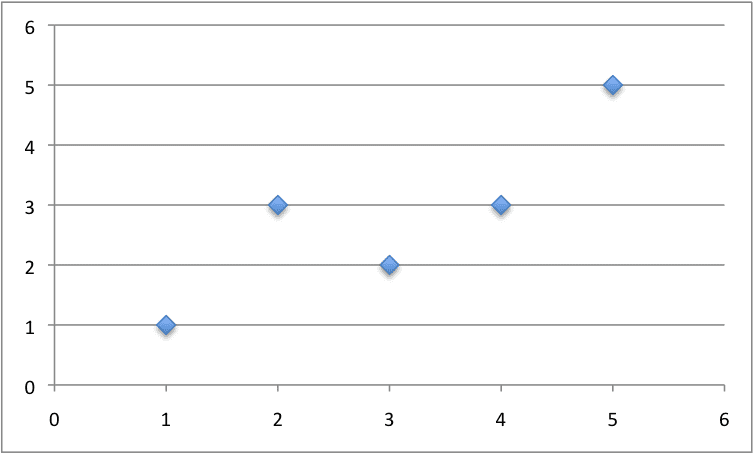The core of many machine learning algorithms is optimization.
Optimization algorithms are used by machine learning algorithms to find a good set of model parameters given a training dataset.
The most common optimization algorithm used in machine learning is stochastic gradient descent.
In this tutorial, you will discover how to implement stochastic gradient descent to optimize a linear regression algorithm from scratch with Python.
After completing this tutorial, you will know:
- How to estimate linear regression coefficients using stochastic gradient descent.
- How to make predictions for multivariate linear regression.
- How to implement linear regression with stochastic gradient descent to make predictions on new data.
Kick-start your project with my new book Machine Learning Algorithms From Scratch, including step-by-step tutorials and the Python source code files for all examples.
Let’s get started.
- Update Jan/2017: Changed the calculation of fold_size in cross_validation_split() to always be an integer. Fixes issues with Python 3.
- Update Aug/2018: Tested and updated to work with Python 3.6.

How to Implement Linear Regression With Stochastic Gradient Descent From Scratch With Python
Photos by star5112, some rights reserved.
Description
In this section, we will describe linear regression, the stochastic gradient descent technique and the wine quality dataset used in this tutorial.
Multivariate Linear Regression
Linear regression is a technique for predicting a real value.
Confusingly, these problems where a real value is to be predicted are called regression problems.
Linear regression is a technique where a straight line is used to model the relationship between input and output values. In more than two dimensions, this straight line may be thought of as a plane or hyperplane.
Predictions are made as a combination of the input values to predict the output value.
Each input attribute (x) is weighted using a coefficient (b), and the goal of the learning algorithm is to discover a set of coefficients that results in good predictions (y).
|
1 |
y = b0 + b1 * x1 + b2 * x2 + ... |
Coefficients can be found using stochastic gradient descent.
Stochastic Gradient Descent
Gradient Descent is the process of minimizing a function by following the gradients of the cost function.
This involves knowing the form of the cost as well as the derivative so that from a given point you know the gradient and can move in that direction, e.g. downhill towards the minimum value.
In machine learning, we can use a technique that evaluates and updates the coefficients every iteration called stochastic gradient descent to minimize the error of a model on our training data.
The way this optimization algorithm works is that each training instance is shown to the model one at a time. The model makes a prediction for a training instance, the error is calculated and the model is updated in order to reduce the error for the next prediction. This process is repeated for a fixed number of iterations.
This procedure can be used to find the set of coefficients in a model that result in the smallest error for the model on the training data. Each iteration, the coefficients (b) in machine learning language are updated using the equation:
|
1 |
b = b - learning_rate * error * x |
Where b is the coefficient or weight being optimized, learning_rate is a learning rate that you must configure (e.g. 0.01), error is the prediction error for the model on the training data attributed to the weight, and x is the input value.
Wine Quality Dataset
After we develop our linear regression algorithm with stochastic gradient descent, we will use it to model the wine quality dataset.
This dataset is comprised of the details of 4,898 white wines including measurements like acidity and pH. The goal is to use these objective measures to predict the wine quality on a scale between 0 and 10.
Below is a sample of the first 5 records from this dataset.
|
1 2 3 4 5 |
7,0.27,0.36,20.7,0.045,45,170,1.001,3,0.45,8.8,6 6.3,0.3,0.34,1.6,0.049,14,132,0.994,3.3,0.49,9.5,6 8.1,0.28,0.4,6.9,0.05,30,97,0.9951,3.26,0.44,10.1,6 7.2,0.23,0.32,8.5,0.058,47,186,0.9956,3.19,0.4,9.9,6 7.2,0.23,0.32,8.5,0.058,47,186,0.9956,3.19,0.4,9.9,6 |
The dataset must be normalized to the values between 0 and 1 as each attribute has different units and in turn different scales.
By predicting the mean value (Zero Rule Algorithm) on the normalized dataset, a baseline root mean squared error (RMSE) of 0.148 can be achieved.
You can learn more about the dataset on the UCI Machine Learning Repository.
You can download the dataset and save it in your current working directory with the name winequality-white.csv. You must remove the header information from the start of the file, and convert the “;” value separator to “,” to meet CSV format.
Tutorial
This tutorial is broken down into 3 parts:
- Making Predictions.
- Estimating Coefficients.
- Wine Quality Prediction.
This will provide the foundation you need to implement and apply linear regression with stochastic gradient descent on your own predictive modeling problems.
1. Making Predictions
The first step is to develop a function that can make predictions.
This will be needed both in the evaluation of candidate coefficient values in stochastic gradient descent and after the model is finalized and we wish to start making predictions on test data or new data.
Below is a function named predict() that predicts an output value for a row given a set of coefficients.
The first coefficient in is always the intercept, also called the bias or b0 as it is standalone and not responsible for a specific input value.
|
1 2 3 4 5 6 |
# Make a prediction with coefficients def predict(row, coefficients): yhat = coefficients[0] for i in range(len(row)-1): yhat += coefficients[i + 1] * row[i] return yhat |
We can contrive a small dataset to test our prediction function.
|
1 2 3 4 5 6 |
x, y 1, 1 2, 3 4, 3 3, 2 5, 5 |
Below is a plot of this dataset.

Small Contrived Dataset For Linear Regression
We can also use previously prepared coefficients to make predictions for this dataset.
Putting this all together we can test our predict() function below.
|
1 2 3 4 5 6 7 8 9 10 11 12 |
# Make a prediction with coefficients def predict(row, coefficients): yhat = coefficients[0] for i in range(len(row)-1): yhat += coefficients[i + 1] * row[i] return yhat dataset = [[1, 1], [2, 3], [4, 3], [3, 2], [5, 5]] coef = [0.4, 0.8] for row in dataset: yhat = predict(row, coef) print("Expected=%.3f, Predicted=%.3f" % (row[-1], yhat)) |
There is a single input value (x) and two coefficient values (b0 and b1). The prediction equation we have modeled for this problem is:
|
1 |
y = b0 + b1 * x |
or, with the specific coefficient values we chose by hand as:
|
1 |
y = 0.4 + 0.8 * x |
Running this function we get predictions that are reasonably close to the expected output (y) values.
|
1 2 3 4 5 |
Expected=1.000, Predicted=1.200 Expected=3.000, Predicted=2.000 Expected=3.000, Predicted=3.600 Expected=2.000, Predicted=2.800 Expected=5.000, Predicted=4.400 |
Now we are ready to implement stochastic gradient descent to optimize our coefficient values.
2. Estimating Coefficients
We can estimate the coefficient values for our training data using stochastic gradient descent.
Stochastic gradient descent requires two parameters:
- Learning Rate: Used to limit the amount each coefficient is corrected each time it is updated.
- Epochs: The number of times to run through the training data while updating the coefficients.
These, along with the training data will be the arguments to the function.
There are 3 loops we need to perform in the function:
- Loop over each epoch.
- Loop over each row in the training data for an epoch.
- Loop over each coefficient and update it for a row in an epoch.
As you can see, we update each coefficient for each row in the training data, each epoch.
Coefficients are updated based on the error the model made. The error is calculated as the difference between the prediction made with the candidate coefficients and the expected output value.
|
1 |
error = prediction - expected |
There is one coefficient to weight each input attribute, and these are updated in a consistent way, for example:
|
1 |
b1(t+1) = b1(t) - learning_rate * error(t) * x1(t) |
The special coefficient at the beginning of the list, also called the intercept or the bias, is updated in a similar way, except without an input as it is not associated with a specific input value:
|
1 |
b0(t+1) = b0(t) - learning_rate * error(t) |
Now we can put all of this together. Below is a function named coefficients_sgd() that calculates coefficient values for a training dataset using stochastic gradient descent.
|
1 2 3 4 5 6 7 8 9 10 11 12 13 14 |
# Estimate linear regression coefficients using stochastic gradient descent def coefficients_sgd(train, l_rate, n_epoch): coef = [0.0 for i in range(len(train[0]))] for epoch in range(n_epoch): sum_error = 0 for row in train: yhat = predict(row, coef) error = yhat - row[-1] sum_error += error**2 coef[0] = coef[0] - l_rate * error for i in range(len(row)-1): coef[i + 1] = coef[i + 1] - l_rate * error * row[i] print('>epoch=%d, lrate=%.3f, error=%.3f' % (epoch, l_rate, sum_error)) return coef |
You can see, that in addition, we keep track of the sum of the squared error (a positive value) each epoch so that we can print out a nice message in the outer loop.
We can test this function on the same small contrived dataset from above.
|
1 2 3 4 5 6 7 8 9 10 11 12 13 14 15 16 17 18 19 20 21 22 23 24 25 26 27 28 |
# Make a prediction with coefficients def predict(row, coefficients): yhat = coefficients[0] for i in range(len(row)-1): yhat += coefficients[i + 1] * row[i] return yhat # Estimate linear regression coefficients using stochastic gradient descent def coefficients_sgd(train, l_rate, n_epoch): coef = [0.0 for i in range(len(train[0]))] for epoch in range(n_epoch): sum_error = 0 for row in train: yhat = predict(row, coef) error = yhat - row[-1] sum_error += error**2 coef[0] = coef[0] - l_rate * error for i in range(len(row)-1): coef[i + 1] = coef[i + 1] - l_rate * error * row[i] print('>epoch=%d, lrate=%.3f, error=%.3f' % (epoch, l_rate, sum_error)) return coef # Calculate coefficients dataset = [[1, 1], [2, 3], [4, 3], [3, 2], [5, 5]] l_rate = 0.001 n_epoch = 50 coef = coefficients_sgd(dataset, l_rate, n_epoch) print(coef) |
We use a small learning rate of 0.001 and train the model for 50 epochs, or 50 exposures of the coefficients to the entire training dataset.
Running the example prints a message each epoch with the sum squared error for that epoch and the final set of coefficients.
|
1 2 3 4 5 6 |
>epoch=45, lrate=0.001, error=2.650 >epoch=46, lrate=0.001, error=2.627 >epoch=47, lrate=0.001, error=2.607 >epoch=48, lrate=0.001, error=2.589 >epoch=49, lrate=0.001, error=2.573 [0.22998234937311363, 0.8017220304137576] |
You can see how error continues to drop even in the final epoch. We could probably train for a lot longer (more epochs) or increase the amount we update the coefficients each epoch (higher learning rate).
Experiment and see what you come up with.
Now, let’s apply this algorithm on a real dataset.
3. Wine Quality Prediction
In this section, we will train a linear regression model using stochastic gradient descent on the wine quality dataset.
The example assumes that a CSV copy of the dataset is in the current working directory with the filename winequality-white.csv.
The dataset is first loaded, the string values converted to numeric and each column is normalized to values in the range of 0 to 1. This is achieved with helper functions load_csv() and str_column_to_float() to load and prepare the dataset and dataset_minmax() and normalize_dataset() to normalize it.
We will use k-fold cross-validation to estimate the performance of the learned model on unseen data. This means that we will construct and evaluate k models and estimate the performance as the mean model error. Root mean squared error will be used to evaluate each model. These behaviors are provided in the cross_validation_split(), rmse_metric() and evaluate_algorithm() helper functions.
We will use the predict(), coefficients_sgd() and linear_regression_sgd() functions created above to train the model.
Below is the complete example.
|
1 2 3 4 5 6 7 8 9 10 11 12 13 14 15 16 17 18 19 20 21 22 23 24 25 26 27 28 29 30 31 32 33 34 35 36 37 38 39 40 41 42 43 44 45 46 47 48 49 50 51 52 53 54 55 56 57 58 59 60 61 62 63 64 65 66 67 68 69 70 71 72 73 74 75 76 77 78 79 80 81 82 83 84 85 86 87 88 89 90 91 92 93 94 95 96 97 98 99 100 101 102 103 104 105 106 107 108 109 110 111 112 113 114 115 116 117 118 119 120 121 122 123 124 125 |
# Linear Regression With Stochastic Gradient Descent for Wine Quality from random import seed from random import randrange from csv import reader from math import sqrt # Load a CSV file def load_csv(filename): dataset = list() with open(filename, 'r') as file: csv_reader = reader(file) for row in csv_reader: if not row: continue dataset.append(row) return dataset # Convert string column to float def str_column_to_float(dataset, column): for row in dataset: row[column] = float(row[column].strip()) # Find the min and max values for each column def dataset_minmax(dataset): minmax = list() for i in range(len(dataset[0])): col_values = [row[i] for row in dataset] value_min = min(col_values) value_max = max(col_values) minmax.append([value_min, value_max]) return minmax # Rescale dataset columns to the range 0-1 def normalize_dataset(dataset, minmax): for row in dataset: for i in range(len(row)): row[i] = (row[i] - minmax[i][0]) / (minmax[i][1] - minmax[i][0]) # Split a dataset into k folds def cross_validation_split(dataset, n_folds): dataset_split = list() dataset_copy = list(dataset) fold_size = int(len(dataset) / n_folds) for i in range(n_folds): fold = list() while len(fold) < fold_size: index = randrange(len(dataset_copy)) fold.append(dataset_copy.pop(index)) dataset_split.append(fold) return dataset_split # Calculate root mean squared error def rmse_metric(actual, predicted): sum_error = 0.0 for i in range(len(actual)): prediction_error = predicted[i] - actual[i] sum_error += (prediction_error ** 2) mean_error = sum_error / float(len(actual)) return sqrt(mean_error) # Evaluate an algorithm using a cross validation split def evaluate_algorithm(dataset, algorithm, n_folds, *args): folds = cross_validation_split(dataset, n_folds) scores = list() for fold in folds: train_set = list(folds) train_set.remove(fold) train_set = sum(train_set, []) test_set = list() for row in fold: row_copy = list(row) test_set.append(row_copy) row_copy[-1] = None predicted = algorithm(train_set, test_set, *args) actual = [row[-1] for row in fold] rmse = rmse_metric(actual, predicted) scores.append(rmse) return scores # Make a prediction with coefficients def predict(row, coefficients): yhat = coefficients[0] for i in range(len(row)-1): yhat += coefficients[i + 1] * row[i] return yhat # Estimate linear regression coefficients using stochastic gradient descent def coefficients_sgd(train, l_rate, n_epoch): coef = [0.0 for i in range(len(train[0]))] for epoch in range(n_epoch): for row in train: yhat = predict(row, coef) error = yhat - row[-1] coef[0] = coef[0] - l_rate * error for i in range(len(row)-1): coef[i + 1] = coef[i + 1] - l_rate * error * row[i] # print(l_rate, n_epoch, error) return coef # Linear Regression Algorithm With Stochastic Gradient Descent def linear_regression_sgd(train, test, l_rate, n_epoch): predictions = list() coef = coefficients_sgd(train, l_rate, n_epoch) for row in test: yhat = predict(row, coef) predictions.append(yhat) return(predictions) # Linear Regression on wine quality dataset seed(1) # load and prepare data filename = 'winequality-white.csv' dataset = load_csv(filename) for i in range(len(dataset[0])): str_column_to_float(dataset, i) # normalize minmax = dataset_minmax(dataset) normalize_dataset(dataset, minmax) # evaluate algorithm n_folds = 5 l_rate = 0.01 n_epoch = 50 scores = evaluate_algorithm(dataset, linear_regression_sgd, n_folds, l_rate, n_epoch) print('Scores: %s' % scores) print('Mean RMSE: %.3f' % (sum(scores)/float(len(scores)))) |
A k value of 5 was used for cross-validation, giving each fold 4,898/5 = 979.6 or just under 1000 records to be evaluated upon each iteration. A learning rate of 0.01 and 50 training epochs were chosen with a little experimentation.
You can try your own configurations and see if you can beat my score.
Running this example prints the scores for each of the 5 cross-validation folds then prints the mean RMSE.
We can see that the RMSE (on the normalized dataset) is 0.126, lower than the baseline value of 0.148 if we just predicted the mean (using the Zero Rule Algorithm).
|
1 2 |
Scores: [0.12248058224159092, 0.13034017509167112, 0.12620370547483578, 0.12897687952843237, 0.12446990678682233] Mean RMSE: 0.126 |
Extensions
This section lists a number of extensions to this tutorial that you may wish to consider exploring.
- Tune The Example. Tune the learning rate, number of epochs and even the data preparation method to get an improved score on the wine quality dataset.
- Batch Stochastic Gradient Descent. Change the stochastic gradient descent algorithm to accumulate updates across each epoch and only update the coefficients in a batch at the end of the epoch.
- Additional Regression Problems. Apply the technique to other regression problems on the UCI machine learning repository.
Did you explore any of these extensions?
Let me know about it in the comments below.
Review
In this tutorial, you discovered how to implement linear regression using stochastic gradient descent from scratch with Python.
You learned.
- How to make predictions for a multivariate linear regression problem.
- How to optimize a set of coefficients using stochastic gradient descent.
- How to apply the technique to a real regression predictive modeling problem.
Do you have any questions?
Ask your question in the comments below and I will do my best to answer.








Thanks, Jason, for keeping it as simple and straight as it can be. The tutorial was quite helpful.
I’m glad to hear that Blessing.
Are you handpicking the coefficients so that you have something to go off of for training? Why don’t you just use random values for the coefficients, and then go directly into gradient descent?
In the final example (end of the tutorial), I use the initial coefficients of “0” and use SGD to search for coefficients that best fit the data.
you are feed the sdg with the label of the test (line 70 -74):
I don’t believe so, we are operating on the list that happens to be in the test set list.
E.g. a reference to the list.
Hi Jason,
this blog is really awesome and the more i read the more questions appear. Here for instance i don’t get why the wine dataset is actually labeled as regression problem? We have fixed class labels so it should be a categorical classification right?
I would also like to know if you would recommend also standardizing the labels too or is it enough to do this with the features? Google is not totally clear about that so i prefer an expert’s opinion. Thanks
You could treat the problem as classification, try it and see (with a different algorithm).
Standardization can help. Again try it on your problem and see.
Hi Jason,
Have a question on finding the optimal coeff? What I understood from the equation of Gradient Descent :
coeff(0) = coeff(0) – l_rate *1\m*errors
coeff(1) = coeff(1) – l_rate * 1\m * errors * X[i]
where m is no.of training rows.
But in the above code I couldn’t figure out 1\m part. Could you explain me whats wrong in my understanding of the gradient descent equation.
I did not include the scaling term 1/m. You can if you like.
I seem to get different values for my coefficients and sum_error when I incorporate 1/m. Should this be so?
Yes, see this post:
https://machinelearningmastery.com/randomness-in-machine-learning/
The problem is the Error’s Definition… which it is NOT CORRECT!
It defines as yhat – y … and this can means that 2 examples with +1 and -1 of error summarize 0 error.
The correct definition would be 1/2 (yhat – y)^2 …. and in the updates, the derivation includes X_i. ….
Hi there Jason,
The problem you solving here is searching for coefficients that fitting straight line to the data. But how to visualize the result of this algorithm, is it even possible?
Yes, you can feed in each possible input variable (x) to the learned model and collect the output variable (y), then plot the x,y points.
When dealing with many inputs(>3) how do we visualize the data, because in the wine quality dataset there are 11 features/inputs.
You can use pair-wise scatter plots.
Hi Jason,
I am working with a dataset with 6 columns per row, where the first 5 values (say, a,b,c,d,e) are input variables that produce the 6th value as an output (say, y). Now if I want to utilize SGD, as implemented above, to find a set of a,b,c,d,e that maximizes y (minimizes 1-y), how would I go about this? Thanks for your tutorials, they’re incredibly helpful for someone just starting out!
You may want to start with a standard tool like Weka:
https://machinelearningmastery.com/start-here/#weka
Hi Jason,
I’m applying your tutorial to a modeling scenario with 5 inputs, one output, input and output variable scale in the 10^4 to 10^5 range (it is a media modeling example estimating cost efficiency where we typically don’t normalize in pre-processing). In comparing your methods with the SKlearn linear regression, I’m finding that I can’t estimate the intercept very accurately using your method, and my coefficients and intercept all converge to some reasonably small and similar values, (initializing all coefficients as 0). When initializing the intercept term to be similar to the SKlearn linear regression intercept result, your method converges to exactly the result of SKlearn linear regression. Would you say that your method is dependent on the initialization of coefficients, and is this a phenomenon you’ve encountered before? I’m curious if I am overlooking something, or if this is dependent on the scale of the data, or if this is the result of the data having an apparently large intercept.
I also want to note that when comparing your method to SKlearn linear regression with no intercept, it is perfect.
Gradient descent is more suitable when you cannot use the linalg methods (like sklearn) that require all data to fit into memory.
The GD method may need to be tuned on your problem, e.g. learning rate, batch size, etc.
Hi Jason
thank you for these awesome tutorials,
Are you initializing coef[0] and coef[1] = 0 in the below code?
debugging through for loops is confusing
coef = [0.0 for i in range(len(train[0]))]
Yes, zero init.
Thank u so much sir for your efforts….
Sir can u tell how to omit first row of csv file
Some ideas:
– Delete it manually
– Skip it when loading with read_csv
– Load it then delete it from the dataframe using pandas or from the array using numpy later.
I hope that helps as a start.
sir when i call ds.info its shows that it read it as a single column plzz can u tell how to fix this problem
this is code:
df=pd.read_csv(‘wine1.csv’)
df.info()
OUTPUT:
class ‘pandas.core.frame.DataFrame’>
RangeIndex: 4898 entries, 0 to 4897
Data columns (total 1 columns):
fixed acidity;”volatile acidity”;”citric acid”;”residual sugar”;”chlorides”;”free sulfur dioxide”;”total sulfur dioxide”;”density”;”pH”;”sulphates”;”alcohol”;”quality” 4898 non-null object
dtypes: object(1)
memory usage: 38.3+ KB
You may need to configure the loading to separate the columns by ‘;’ instead of ‘,’.
See the API here:
https://pandas.pydata.org/pandas-docs/stable/generated/pandas.read_csv.html
Great tutorial thanks you.
However i find myself stuck on a problem. One of the value of the wine dataset (total sulfur dioxide) if way greater than the others and it create an unstable situation where the error and the coefficient soar, switching from positive to negative, causing an overflow. I can’t even go through 200 lines of the dataset. I checked my code and copy past yours but nothing changed.
Is this a classic issue ? Is there a simple solution ?
Sorry to hear that.
Perhaps you can identify that example and remove it from the dataset?
Hi Jason,
I am working on Campaign Analysis and using Linear Regression following cross validation, SGD in Python.Previously applying Linear Regression using 80% train set and 20% test set i used to get the prediction and recommend in terms of the deciles, where as in this technique recommended by you how can i divide my dataset into deciles and recommend?
They are two different ways of estimating the skill of the model on unseen data.
Use the approach that gives you the least biased estimates.
So if i adopt your approach of cross validation i am getting 5 rows of Coefficients as fold =5..For my final linear regression equation which coefficients should i choose in order to finalize my equation and then derive the decile split for recommendation?
Once you choose a model configuration, you can fit a final model on all data and use it for making predictions.
More about developing a final model here:
https://machinelearningmastery.com/train-final-machine-learning-model/
Thanks for the reply!u really helped me!
I’m glad to hear that.
Hi Jason,
Here you are updating the weightages after every sample, but as per SGD it should be after a batch processing. Can you please explain?
Updating after each example is called “stochastic gradient descent”.
Updating after batches of samples is called “mini-batch gradient descent”.
Learn more about the differences here:
https://machinelearningmastery.com/gentle-introduction-mini-batch-gradient-descent-configure-batch-size/
How can we add regularization in it, where, regularization norm is a general p-norm with 1<=p<=2 (p=1 being lasso and p=2 ridge)?
Update the loss function to take into account the magnitude of the combined coefficients.
Sorry, I do not have worked example (yet).
wont (minmax[i][1] – minmax[i][0]) will result in 0 division
Why?
File “C:/tutorials/pure-python-lessons/linear-regression/stochastic-regression-protect-nan.py”, line 37, in normalize_dataset
row[i] = (row[i] – minmax[i][0]) / (minmax[i][1] – minmax[i][0])
ZeroDivisionError: float division by zero
The csv is
7,0.27,0.36,20.7,0.045,45,170,1.001,3,0.45,8.8,6
6.3,0.3,0.34,1.6,0.049,14,132,0.994,3.3,0.49,9.5,6
8.1,0.28,0.4,6.9,0.05,30,97,0.9951,3.26,0.44,10.1,6
7.2,0.23,0.32,8.5,0.058,47,186,0.9956,3.19,0.4,9.9,6
7.2,0.23,0.32,8.5,0.058,47,186,0.9956,3.19,0.4,9.9,6
It suggests that perhaps one of your columns has all the same value. Perhaps you can remove this column?
Hi Jason
The data I used is from this page. You posted it as a wine quality stats.
Indeed when I change it so the last column wont be unanimous the error no longer appears.
But of course this can happen in other data sets.
will it be correct to change the code to the following?
def normalize_dataset(dataset, minmax):
for row in dataset:
for i in range(len(row)):
if minmax[i][1] == minmax[i][0]:
row[i] = 0
else:
row[i] = (row[i] – minmax[i][0]) / (minmax[i][1] – minmax[i][0])
Normally we would remove columns that have no information like the one you describe.
hi Jason,
So why using stochastic gradient descent? rather than others ? for example gradient descent with sum squares?
The main reason is when the matrix of input data does not fit into memory meaning the linalg solution cannot be calculated.
ValueError: could not convert string to float: fixed acidity;”volatile acidity”;”citric acid”;”residual sugar”;”chlorides”;”free sulfur dioxide”;”total sulfur dioxide”;”density”;”pH”;”sulphates”;”alcohol”;”quality”
Looks like you are working with a different dataset that might need to be processed first.
Hey, I had the same problem. The Problem is the delimiter in the csv file. You just need to change line 11 from
csv_reader = reader(file)
to
csv_reader = reader(file,delimiter=’;’)
Hi Jason,
in Line 47, you fill you fold list with random indexed entries from the dataset. That means that some points will appear more than once in a fold, and that not every point is used, right? Wouldnt it be better to use every point?
Thanks in advance!
Not quite, you can learn more about cross validation here:
https://machinelearningmastery.com/k-fold-cross-validation/
Hi Jason,
I tried your example and all works well, however I tried to use the function to estimate the coefficients on a different dataset with negative relations between predictors and the target variable and this function does not seem to give any negative coefficients. I tried different learning rates but that is not it.
Hope you can point me in the right direction where I go wrong here.
The dataset I used is the mtcars dataset with disp and hp as examples of columns negatively correlated with mpg.
Perhaps try scaling the data before fitting the model?
Hi Jason,
Thank you for your awesome tutorials.
I’m trying your SGD with my dataset. My dataset has 6 features a,b,c,d,e,f and g is target result which I have to predict. some rows in my dataset like this:
a b c d e f g
8 20 2 8 1 0 162401
7 30 2 16 1 0 157731
7 30 2 10 1 0 174087
7 30 2 14 1 0 175439
7 30 2 11 1 0 137424
So, my problem here is if i normalize data like this tutorial, I must normalize g column, too. and after I have coefficients vector, how can i predict the result with my test data? because the value of elements in coef vector is very small. On the other hand, the actual result of g column is very large.
You must normalize test data as well, using the min/max from the training data.
Hi, Jason. Thank you for your explanation.
But I have one question. Could you tell me why are you using error instead of gradient?
I’m looking forward your answer.
Thank you 🙂
We navigate down the error gradient.
Jason where do you get the 0,148 number?
We can see that the RMSE (on the normalized dataset) is 0.126, lower than the baseline value of 0.148 if we just predicted the mean (using the Zero Rule Algorithm).
Thanks
Ken
I ran an zeror on the dataset beforehand.
Earlier in the tutorial I noted:
Hi Jason,
In yours tutorial , what is the feature you considered as response variable (target) ?
Thanks in advance
Wine quality.
why do not use sklearn models.why u use regular program code.is it there any difference between them and any complexity
I recommend using sklearn in general.
I show how to code it from scratch as a learning exercise only.
Hi,
i was trying to run or follow your steps i am getting below error
OverflowError: (34, ‘Numerical result out of range’)
in evaluate_algorithm(dataset, algorithm, n_folds, *args)
12 test_set.append(row_copy)
13 row_copy[-1] = None
—> 14 predicted = algorithm(train_set, test_set, *args)
15 actual = [row[-1] for row in fold]
16 rmse = rmse_metric(actual, predicted)
in linear_regression_sgd(train, test, l_rate, n_epoch)
21 def linear_regression_sgd(train, test, l_rate, n_epoch):
22 predictions = list()
—> 23 coef = coefficients_sgd(train, l_rate, n_epoch)
24 for row in test:
25 yhat = predict(row, coef)
in coefficients_sgd(train, l_rate, n_epoch)
35 yhat = predict(row, coef)
36 error = yhat – row[-1]
—> 37 sum_error += error**2
38 coef[0] = coef[0] – l_rate * error
39 for i in range(len(row)-1):
I have some suggestions here:
https://machinelearningmastery.com/faq/single-faq/why-does-the-code-in-the-tutorial-not-work-for-me
Hi i’m going to apply SGD for linear regression with sk learn’s Boston dataset can you share me some good resource like you
This post (above) is all you really need and a great place to start.
Hi Jason! Thanks for your work. A am somewhat beginner in the ML algorithms, especially in the math part of it. I am thinking all the day how you derivated the error function. I know that the error function in the code is (error = yhat – row(-1)), and yhat is taken from the function predict. From what I understand, the predict function in the math is something like (f(x) = x0 + n – 1
Σ
i = 1
xi * d(i-1)
where d is the data and n is the length. I tried to get the derivative function, but looks like I am doing it in the wrong way.
I did not derive the error function, I used a derivation from a book.
Thank you very much for the reply! I (after much thinking) concluded that the derived part in the code is not
error * row(i)
but only
row(i)
based on the derivation of the straight line function
f'(x) (a + bx – y) = b
and concluded that the gradient descent algorithm works by subtracting from the coefficients
error * derivation * lrate
and not
derivation * lrate
, but in the “Estimating Coefficients” part of the tutorial, if I change the line 19 with
coef(i + 1) = coef(i + 1) – l_rate * row(i)
the final result is
epoch = 50, lRate = 0.01, error = 1043.0016830658
16.8916015949 -7.5
which tells that “* error” part of the code is with a very good reason there and not by try and guess and most likely I am getting it in the wrong way but I will continue to try understanding it.
Sorry for long reply but I started implementing neural nets from scratch based in some codes there in the net, and now I am analyzing it, and I think that the optimizing algorithm used by the neural nets especially the derivation part of it is very important and I don’t want to continue without understanding it well.
Hi! I understood why is the derivation described in that way in the code, I will share it with you. I will denote the coef[0] with b, other coef’s with mi and the datas with xi.
The error in the code in fact is the derivation of SSE function in respect to b divided by 2 thus 2*error = ∂[SSE]/∂[b]. The derivation of SSE function with respect to mi is simply the derivation of SSE function with respect to b * xi (thus xi * error part in the code). The author removed the “* 2” part of the derivation maybe for simplicity or because it is only a constant the effect of which can be easily replaced by tuning the value of l_rate.
Thanks.
1. Graph plot of epoch number Vs Error (cost)
2. Graph plot of 10 different learning rate Vs Error (cost)
3. Graph plot of 10 different value for parameters (θ0 andθ1) Vs Error (cost)
4. Gradient descent algorithm should stop running instead of running till last epoch when error
(cost) is not getting decreased much compared last few epochs.
5. Dataset should be divided randomly like 70% for training and 30% for testing, so algorithm
should calculate parameters (θ0 andθ1) values by using only 70% data and find both training
error (cost) and testing error (cost).
Is there a question I can help you with?
What do the score values represent? Are the the R squared values?
They are RMSE scores for each fold in the cross validation.
Thank you sir for the wonderful article. I have just started learning ML.
I have a doubt in above implementation. I have read that for SGD Update, we need to take the 1. Derivative of Loss Function “L” with respect to “W” lets call it as “dLW”, and
2. Derivative of Loss Function “L” with respect to “b” lets call it as “dLb”.
Then
let “j” be iteration, then update be like
now W(j+1)=W(j)-LearningRate(r)*dWL
and b(j+1)=b(j)-LearningRate(r)*dLb
sir, can you pls redirect me where are we performing these dericative steps in the above code.
sorry, I am a newbie and learning a lot from you.
Thank You
See the coefficients_sgd() function.
Hello Mr. Brownlee, inside the function we multiply learning rate with calculated error end of epochs. Are we not supposed to use partial derrivatives to calculate new coefficients. Is this process used only in ANN’s?
Similar.
Hello, Jason. Can we get the predicted values alongside the expected value for the wine-quality prediction as we did in example, 1?
Yes, you can fit the model and call prediction, then output the expected vs predicted examples.
This can be achieved by adapting the final example in the tutorial.
Thank you.
You’re welcome.
Hello, Jason. When I use the code to train my dataset, there exists some error. Here is the error:
train_set.remove(fold)
ValueError: The truth value of an array with more than one element is ambiguous. Use a.any() or a.all()
I don’t know how to deal with it, Could you tell me what the problem is and how should I modify?
Sorry to hear that, perhaps confirm that your data was loaded correctly.
Or perhaps use scikit-learn directly instead:
https://machinelearningmastery.com/spot-check-regression-machine-learning-algorithms-python-scikit-learn/
Thanks,I have solved the problem, and I want to ask if the parameter in the ‘coef[i + 1] = coef[i + 1] – l_rate * error * row[i]’ means gradient? Because I just learn it recently so I can not understanding it well.
Yes, error gradient.
Thanks, and if I want to change the stochastic gradient descent to Batch Stochastic Gradient Descent, how should I change? My idea is to use each user’s data to compute the coefficient and then cumpute the mean coefficient. Is that right?If not, how can I change? Hope you could give me some ideas.
Average errors for all examples then perform one update to coefficients at the end of the dataset, then repeat for n epochs.
Here is the quation ablout the Mini-Batch Gradient Descent I found :
β(t+1) = β(t) -γt · 1/|G| ∑|G| i=1 ∇l(i)
Is the parameter ∇l(i) equatl to the varaiable ‘error’ in the code?
Probably.
Hello, Jason.I want to ask if I want to add the regularization factor, how should I update the cofficients? Do I just multiply it by the regularization factor?
You can multiply the prediction error by a penalty term.
Thanks for your answer.By the way ,I want to implement logistic regression and SVM like the linear regression you introduced,do you have some example that is similar to the example description in this article?
Yes, you can find examples on the blog, use the search box.
Hi Jason
I have implemented the code in this tutorial in a Jupyter notebook and it works very well. The model makes predictions (yhat) of the quality of wines as normalized values. How do I transform the normalized prediction values back to int64 or float64?
Once more many thanks for sharing.
Gideon Aswani
You can cast values in python directly, e.g.:
Hi Jason, perhaps I didn’t frame my question properly. The functions load_csv(), str_column_to_float(), dataset_minmax() and normalize_dataset() convert the string values to numeric and normalizes the columns to values in the range of 0 to 1. Predictions (that) are also made with values in this range. My question is, how do we transform these predictions back to string values or numeric values, i.e. “un-normalize the yhats.
You can write code to remember the mapping and invert the process.
Or, you can use scikit-learn transform objects and call inverse_transform().
I actually wrote a few lines of code to reverse the normalization process and I was able to get the predictions on a scale of 1 to 10. I will try the inverse_transform() method in scikit-learn
Nice work!
Hi Jason, in the tutorial you say that “We can see that the RMSE (on the normalized dataset) is 0.126, lower than the baseline value of 0.148 if we just predicted the mean (using the Zero Rule Algorithm). I have used the entire dataset (winequality-white.csv) targets (normalized) as my train set to determine the baseline value using the Zero Rule Algorithm and I am getting a value of 0.479651558459236 as the prediction and not 0.148. What explains this difference?
Similarly in the insurance tutorial using Zero Rule Algorithm on the entire dataset (insurance.csv) I am getting 98.18730158730159 as the prediction instead of 81 thousand kronor. How do I explain the variance?
Good question, see this:
https://machinelearningmastery.com/faq/single-faq/why-do-i-get-different-results-each-time-i-run-the-code
Sir is it compulsory to normalize the dataset because when i tried it on sklearn load_boston dataset it returned an error value of nan
No. Some data and some models may benefit from scaling.
Hi Jason
I have implemented the code in this tutorial in a Jupyter notebook and i have this error :
could not convert string to float: ‘fixed acidity’
can you help me?
Please skip the first row in the CSV file. That’s the column headers.
Hi Constantin…Please try to establish a local installation of Python on your machine if possible according to the following resource:
https://machinelearningmastery.com/setup-python-environment-machine-learning-deep-learning-anaconda/
Then try running your code and let me know if you are still experiencing issues.
Regards,